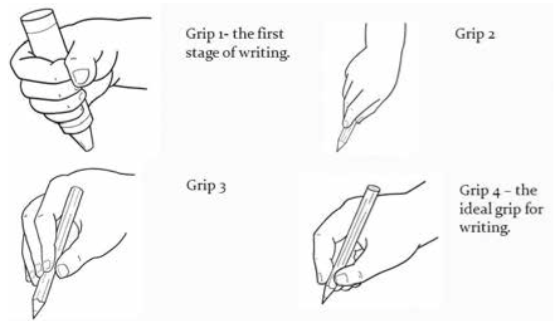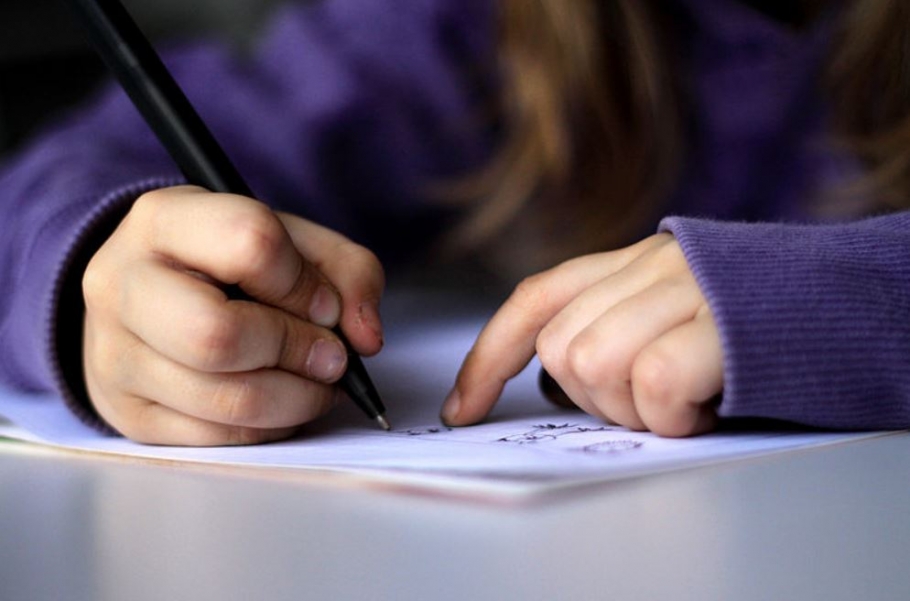There is a great deal of things that you can do to prepare children to become successful writers. The stages of physical writing development in the Early Years can be tricky and different children show different levels of dexterity at different times. It is useful to know the various phases of ‘grip’ children move through as they progress to becoming confident writers.

1/ FISTED GRIP
When your toddler first grabs a thick crayon and puts it to paper (hopefully not to your walls!), this is the grasp you could be seeing. It is a “fisted grasp,” and your toddler will be using move- ment from the shoulder to get the cray- on to move across the paper. All fingers grip around the crayon like a fist.
2/ PALMAR GRIP
As your toddler gains more control over arm and hand muscles, you will see this “palmar grasp” being used. Here, the pencil lies across the palm of the hand and your child’s elbow is held out to the side a bit. The shoulder muscles are steadier, and your child is using the arm muscles to move the crayon around, as well as the shoulder muscles.
3/ PINCER GRIP
This grip is a perfectly mature grip for a four-year-old. You will notice five fingers holding the pencil. With this grip, the wrist is usually held off the table and wrist movements are used for coloring. The crayon is also often held very tightly initially, but as the hand muscles develop, you should see a few finger movements emerging.
4/ TRIPOD GRIP
By age five or six, or even a bit lat- er with some children, they should be comfortable using a mature three-finger pencil grip. At first, the fingers will be held stiffly and your child may still use wrist movements to draw and color, but as the finger muscles become more skilled, your child will be able to use finger move- ments to draw and to form letters.
It is crucial not to force your toddler to hold the pencil the way a school child does, with three fingers on the pencil—you may do more harm than good. It is very hard to “unlearn” a poor pencil grip later in life. In this instance, practice definitely makes imperfect. Once a child has learned to form letters incorrectly, re-teach- ing them is a very difficult task. How we try and help children to improve their letter formation is crucial and if we go about it the wrong way it can put them off writing altogether.
Each stage of holding a pencil or crayon is dependent on how “steady” the shoulder and arm muscles are. As your child develops physically, and takes part in lots of fun gross motor activities such as crawling, climbing and pushing, the shoulder and arm muscles will get stronger and steadier, and this should help your child’s pencil grasp to mature as well.
The biggest inhibitor to attainment in any area of education is self-esteem. With high self-esteem anything is possible, with low-self esteem nothing is worth trying. Just putting pencil to paper can be challenging enough for some children, but to then tell them that the way they are doing it is wrong can be the final nail in the writing coffin.
When a child is forced to use a “proper” pencil grip before the shoulder and arm muscles are ready to support it, you may find fine mo- tor problems emerging, such as holding the pencil in strange ways, messy work and even avoidance
of drawing and coloring tasks.
SWITCHING GRIPS
Don’t be surprised if you see your young child switching between pencil grips. As the shoulder and arm muscles become stronger and steadier, your child should switch less and less. We can liken this to a baby learning to walk—when his legs are tired of walking, he goes back to crawling, but as his endurance and skill improves, he will walk more and more.
So don’t discourage your child from going back to an earlier grip; instead, promote correct pencil grip devel- opment by doing some gross motor activities to strengthen the shoulder and core muscles and use some fine motor activities to improve hand and finger strength and dexterity. Above all, mark making in the Early Years should be fun! Allow your child to experiment with different tools such as paint, crayons, chalks, pencils or even play dough. And it doesn’t have to end with stationary. Try spraying shaving foam into a tray and make marks with your fingers, draw in the sand with a stick or hide items in jelly and squeeze them out with your fingers!
BIO: Rebecca Lambton is Head of Early Years at Saigon Star International School.




